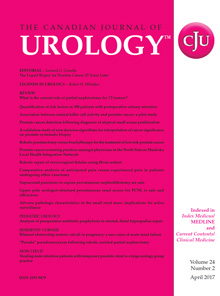 Indexed in Index Medicus and Medline
Indexed in Index Medicus and Medline
HOW I DO IT
-
How I Do It -MRI-ultrasound fusion prostate biopsy using the Fusion MR and Fusion Bx systems
Perlis Nathan, Lawendy Bishoy, Barkin Jack, MD University of Toronto, Department of Surgery, Toronto, Ontario, Canada
There is increasing evidence to support the use of multiparametric magnetic resonance imaging (MRI) in men at risk for clinically significant prostate cancer to help identify lesions and inform biopsy. Randomized, level 1 evidence demonstrates that men who are managed with MRI and MRI-ultrasound fusion targeted biopsy (MRF-TB) have more clinically significant prostate cancer and less clinically insignificant prostate cancer detected and avoid biopsy altogether more often than men who undergo systematic, whole-gland prostate biopsy (SPB). Furthermore, strategies that incorporate MRF-TB have lower rates of upgrading on radical prostatectomy compared to SPB. However, generalizing this data to wider practice is challenging because there is a learning curve for interpreting MRI and performing MRF-TB, and some of the fusion technologies are better than others. We describe our group's early experience with the Fusion MR and Fusion Bx systems (Focal Healthcare, Toronto, ON, Canada). These products are designed with elastic fusion technology that is user-friendly, intuitive and accurate. The Fusion MR contouring system is straightforward and allows for contouring with several MRI sequences simultaneously. The Fusion Bx biopsy system has a semi-robotic arm that accounts for prostate deformation and patient movement and allows for freehand-like access, which is a seamless transition from SPB for clinicians. There were 68 lesions targeted in the first 51 patients. The overall cancer detection rate was 22%/61%/83% for PI-RADS 3/4/5, respectively. The Gleason grade group 2 prostate cancer or higher rate was 6%/47%/75% for PI-RADS 3/4/5, respectively. There were no major complications in this cohort of patients. Limitations of this study include small number of patients and lack of formal follow up to rule out sepsis. Overall, the Fusion MR and Fusion Bx systems are accurate, straightforward and safe to use for MRF-TB. Early experience does not show any significant learning curve.
Keywords: prostate cancer, multiparametric magnetic resonance imaging, systematic prostate biopsy, MRI-ultrasound fusion-targeted biopsy, Gleason grade group,
Apr 2020 (Vol. 27, Issue 2 , Page 10185)PDF (461.9KB)Free -
Anatomic GreenLight laser vaporization-incision technique for benign prostatic hyperplasia using the XPS LBO-180W system: How I do it
Law W. Kyle, Elterman S. Dean, Cash Hannes, Rijo Enrique, Chughtai Bilal, Misrai Vincent, Zorn C. Kevin, MD Department of Urology, University of Montreal Hospital Center CHUM, Montreal, Quebec, Canada
For men experiencing lower urinary tract symptoms (LUTS) refractory to medical therapy, there have been numerous developments in the treatment options offered for benign prostatic hyperplasia (BPH) in the recent years. Transurethral resection of the prostate (TURP) has remained the reference standard for men with prostates sized 30 cc-80 cc, while open prostatectomy is universally guidelines-recommended in the absence of enucleation, for men with prostates larger than 80 cc-100 cc. While these techniques are effective, they have the potential for bleeding complications requiring transfusions, electrolyte abnormalities such as TURP syndrome, and often require prolonged hospitalization. GreenLight photoselective vaporization (GL-PVP) with the XPS LBO-180W system offers a minimally invasive treatment that can be carried out on essential any sized prostate gland. In addition, the GL-PVP procedure can be done as a same day discharge surgery requiring no overnight hospital admission and allows patients to continue any necessary anti-coagulants given the significantly reduced risks of bleeding complications or TURP syndrome. In 2005, the anatomic vaporization-incision technique (VIT) using the XPS LBO-180W system was described to address larger prostate volumes. VIT combines principles of traditional GL-PVP and enucleation techniques to identify the reference surgical capsule early-on into the surgery and resect portions of prostate adenoma without the need for tissue morcellation. Early studies comparing anatomic VIT to standard PVP outcomes demonstrated significant improvements of IPSS and uroflowmetry parameters, along with statistically significant greater PSA reduction at 6 months, particularly in prostate volumes greater than 80 cc. The objective of this article is to detail our surgical approach to the anatomic GreenLight laser vaporization-incision technique using the XPS LBO-180W system, based on extensive personal experience with both enucleation and vaporization techniques using various laser technologies. Standardization of the VIT based on proper cystoscopy, knowledge of prostate anatomy with preoperative ultrasound, and routine technique is essential to developing consistent, reproducible and optimal surgical outcomes.
Keywords: benign prostatic hyperplasia, lower urinary tract symptoms, vaporization-incision technique,
Oct 2019 (Vol. 26, Issue 5 , Page 9963)PDF (1.12MB)Free -
The Rezūm system - a minimally invasive water vapor thermal therapy for obstructive benign prostatic hyperplasia
Cantrill H. Christopher, Zorn C. Kevin, Elterman S. Dean, Gonzalez R. Ricardo, MD Urology San Antonio, San Antonio, Texas, USA
Benign prostatic hyperplasia (BPH) and accompanying lower urinary tract symptoms (LUTS) sits in the top ten prominent and costly disease conditions in men over 50 years of age. In the United States it is the most common diagnosis made by urologists for men 45 to 74 years of age. Twenty percent of the population will reach 65 years of age or older by 2030, and those over 85 years will represent the fastest growing segment of our population. The prevalence of symptomatic BPH increases proportionally with the aging population. It is estimated that BPH now affects 6% of the male population worldwide. Moreover, in Canada, the estimated BPH prevalence is more than 1 million men aged 50 years and older. Among the various surgical treatments, Rezūm water vapor thermal therapy has been developed as a unique, rapid and reproducible minimally invasive surgical treatment exhibiting safe and early effective relief of LUTS/BPH. The targeted prostate tissue ablation is amenable to all zones of the prostate including intravesical median lobes. We present our experiences with this technique, which can be quickly performed under local anesthesia in an office setting.
Keywords: benign prostatic hyperplasia, prostate, LUTS, water vapor thermal therapy, Rezum system, minimally invasive surgical treatment,
Jun 2019 (Vol. 26, Issue 3 , Page 9787) -
How I do it: Apalutamide use in non-metastatic castrate resistant prostate cancer
Moul W. Judd, MD Division of Urology, Department of Surgery and Duke Cancer Institute, Durham, North Carolina, USA
Urologists have been using oral nonsteroidal antiandrogens (AA) for 30 years as a component of combined androgen blockade. In February 2018, a new third generation AA, apalutamide, became available for the first time for non-metastatic (M0) castrate resistant prostate cancer (CRPC). Apalutamide was found to delay the presence of metastases (metastases free survival-MFS) by approximately 2 years versus placebo in M0 CRPC. While overall survival benefit has yet to be established, the MFS benefit is clinically meaningful and urology practices should be equipped to manage patients using this new oral agent. Since the majority of patients remain under urologic care when this disease stage develops and because the drug is straightforward to administer, urology practices are ideal to identify and treat. The objective of this brief article is to discuss the typical patient profile for use of apalutamide and to review the pros and cons of use and common side effects and management.
Keywords: prostate cancer, apalutamide, castrate-resistant, non-metastatic disease, antiandrogen,
Jun 2019 (Vol. 26, Issue 3 , Page 9782) -
How I do it: Surgically inserted transversus abdominis plane (TAP) catheters for flank incisions
Khurana Jaasmit, Ip Vivian, Todd Gerald, Sondekoppam V. Rakesh, MD Department of Anesthesiology and Pain Medicine, University of Alberta, Edmonton, Alberta, Canada
Pain control following major abdominal surgery remains a significant barrier to patient comfort. Although thoracic epidurals have been used to provide analgesia for these surgeries, the transversus abdominis plane (TAP) block is gaining popularity. The TAP catheter insertion method has transformed over the past two decades from a blinded technique to one conducted primarily under ultrasound guidance by anesthesiologists. Recently, however, interest has increased on the potential for direct surgical insertion of catheters into the TAP plane following flank incisions due to anatomical considerations. Proposed advantages include a reduction in operating time, requirement of minimal expertise and increased accuracy of catheter placement. In this report, we describe the rationale and the technique of surgical insertion of TAP catheters following open nephrectomies as performed by urologists at our institution.
Keywords: transversus abdominis plane block, nerve block, open nephrectomy,
Dec 2018 (Vol. 25, Issue 6 , Page 9623)PDF (655.9KB)Free


